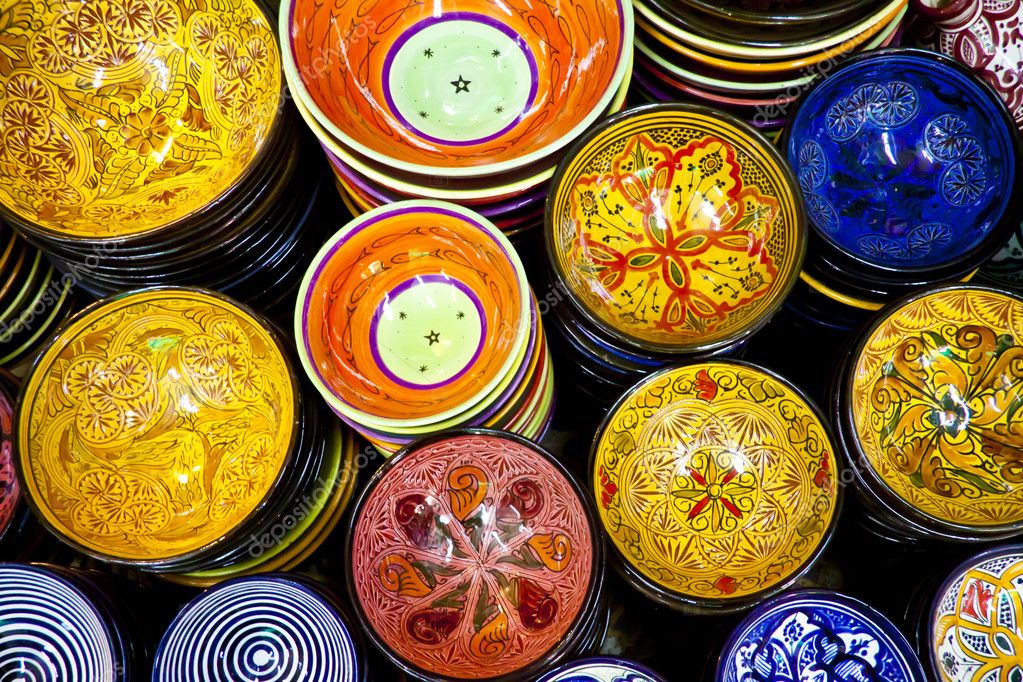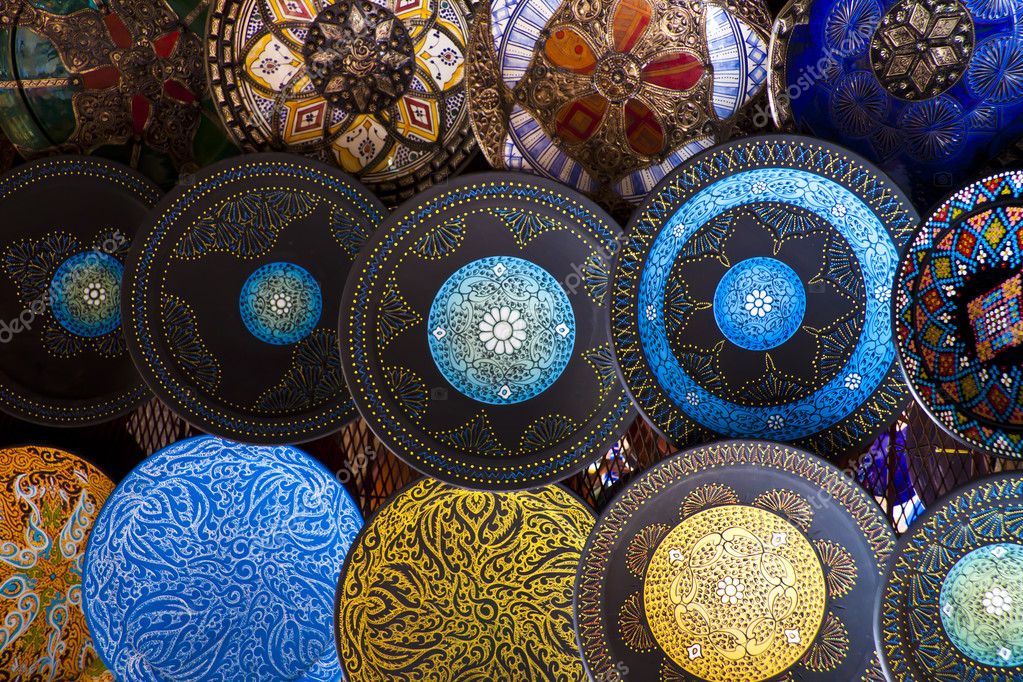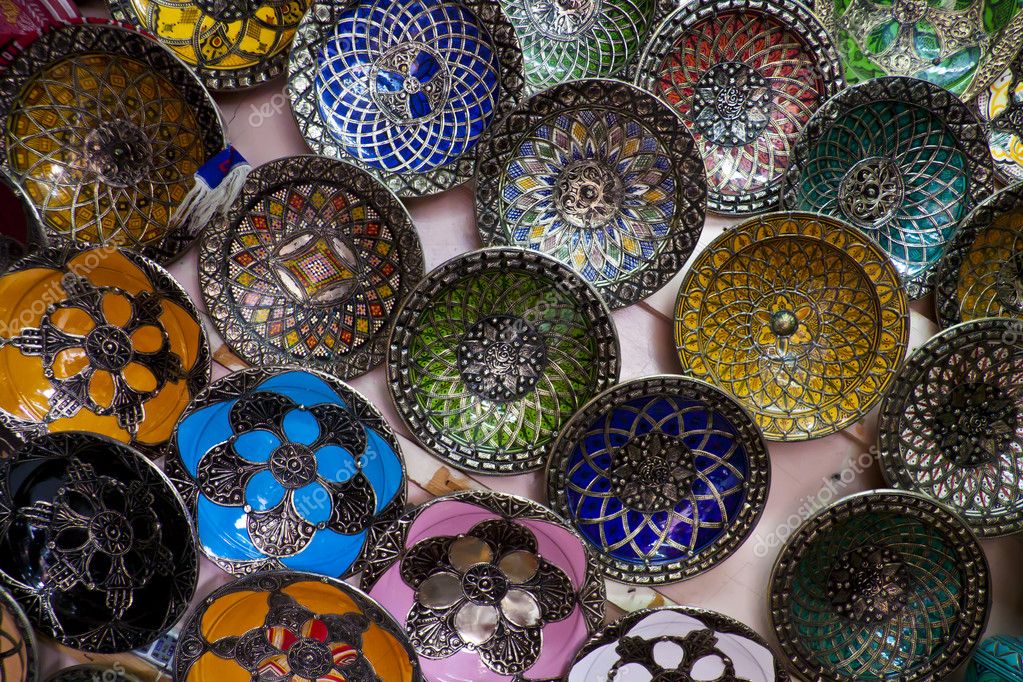Morocco's craft culture fuses indigenous Berber traditions with Arab, Jewish, Andalusian, and other European influences (particularly France), and marries local resources -- stone, wood, metal, mineral and clay deposits, and supplies of leather and wool -- with imports such as marble and silk.
 Moroccan Caravan is owned by Addi Ouadderrou, Amazigh (Berber) a native of Morocco and based in Somerville/Boston, Massachusetts, United States. The Moroccan Caravan always carries authentic high-quality arts and crafts. We care about our friends and customers, we treat them as if they were part of our family and share with them the warmth of Moroccan hospitality. We want you to get things just like the ones we use in our homes.
Moroccan Caravan is owned by Addi Ouadderrou, Amazigh (Berber) a native of Morocco and based in Somerville/Boston, Massachusetts, United States. The Moroccan Caravan always carries authentic high-quality arts and crafts. We care about our friends and customers, we treat them as if they were part of our family and share with them the warmth of Moroccan hospitality. We want you to get things just like the ones we use in our homes.Please keep in mind that shopping at Moroccan Caravan means directly helpping Moroccan artists, keeping alive ancient art forms for everyone's enjoyment.
Take advantage of the specials we have offered
We adjust the shipping cost after we receive orders
We adjust so that our customers pay a friendly s/h rate based on zipcodes, especially when multiple items are combined in the same order.
Morocco's craft culture fuses indigenous Berber traditions with Arab, Jewish, Andalusian, and other European influences (particularly France), and marries local resources -- stone, wood, metal, mineral and clay deposits, and supplies of leather and wool -- with imports such as marble and silk.
 Technique, passed on through specialist guilds where a master maâlem instructs apprentices and examines their skills, is at the core of Moroccan crafts. An extensive repertoire of designs combines Arabic calligraphy, graceful foliage, and abstract geometry typical of urban design with the sharply stylized birds, animals, zigzags, triangles, and squares of Berber origin. Crafts were officially encouraged during the French protectorate (1912-56) through the research of scholars and teachers and during the reign of King Hassan II (1961-99), who sponsored government handicraft centers and training schemes and employed craftsmen on major projects such as the great mosque in Casablanca.
Technique, passed on through specialist guilds where a master maâlem instructs apprentices and examines their skills, is at the core of Moroccan crafts. An extensive repertoire of designs combines Arabic calligraphy, graceful foliage, and abstract geometry typical of urban design with the sharply stylized birds, animals, zigzags, triangles, and squares of Berber origin. Crafts were officially encouraged during the French protectorate (1912-56) through the research of scholars and teachers and during the reign of King Hassan II (1961-99), who sponsored government handicraft centers and training schemes and employed craftsmen on major projects such as the great mosque in Casablanca.
Foreign investment and the development of tourism are powerful incentives for the survival of these traditional crafts. Owners of hotels, guesthouses, and private homes employ builders, decorators, tile makers, wood and stucco carvers, metalworkers, weavers, and embroiderers to create beautiful and comfortably furnished environments. Meanwhile, souks are full of goods -- ceramics, jewelry, clothes, leather bags, slippers -- to attract tourists, and contemporary Moroccan fashion designers make brilliant use of traditional fabrics and decorative techniques in their collections.
Architecture -- Within the imperial cities of Fes, Marrakech, Meknes, and Rabat, traditional life was based on the medina where houses, souks, and craftsmen's workshops clustered around public buildings such as the mosque, medersa (teaching institution), fondouk (travelers inn), communal fountain, and hammam (bathhouse). The ruler's palace was usually located in a defined space outside the medina.
Buildings conform to a basic square or rectangle with an open court concealed from the outside world by high walls. Columned arcades surround the courts of mosques and medersas, one or two stories of rooms enclose the small courtyard of a dar, and walls frame the garden of a riad.
Beyond the cities, the spectacular kasbahs -- residences of local rulers -- and the ksar -- fortified villages -- also have walls enclosing living and storage areas. Before the advent of concrete, bricks made of clay, gravel, and lime were the main building material, reserving local stone for specific features. Gray stone quarried near the port of Essaouira, for example, was used to build the columns and arcades of warehouses and the frames of doors and windows, carved in intricate designs of foliage, stars, and rosettes. Local marble is used in floors, columns, and fountains in wealthy homes. Brick walls are frequently decorated in the technique of tadelakt, which also gives walls a durable, waterproof, and attractive polished surface. This craft involves several stages, including the application of a plaster of powdered limestone mixed with pigments -- usually yellow, rust, brown, or green -- which are burnished when dry and polished with oily black soap.
Three major crafts decorate and furnish Moroccan buildings: woodwork, carved plaster known locally as geps but also called stucco, and ceramic mosaic tilework called zellij. They are seen at their best in the decoration of the medersas (built in the 14th-16th c.) of Fes, Meknes, and Marrakech, and in the surviving palaces and great houses of the 19th and early 20th centuries.
Moroccan interiors are remarkably uncluttered by fittings and furniture. Apart from the arched mihrab niche indicating the direction of prayer toward Mecca, mosques have a minbar, or pulpit, for the preaching of the Friday sermon and a few stands for copies of the Koran, while the medersa only adds a few mats, books, and personal possessions to the students' rooms. Households have little movable furniture except cushions, floor coverings, small tables, and stands, and rooms are multifunctional and easily converted into spaces for dining, sleeping, or entertaining.
Cedar wood from the forests of the Middle Atlas and Rif mountain ranges is used in various woodworking techniques. One of the most beautiful is mashrabiyya, an openwork lattice of small turned pieces of wood joined in patterns of squares, octagons, and stars to form the partitions in the court and rooms of a medersa and in private houses to control the flow of air, filter light, and separate private and public space. In Morocco's medersas, wood was traditionally carved in relief, with bands of religious inscriptions in Arabic, calligraphy in angular Kufic or a flowing cursive script, and panels of spiraling and interlaced foliage mingled with geometric motifs. Wood serves many uses in a household, including kitchen utensils and finely carved tables, shelves, storage chests, jewelry caskets, and containers for ink and cosmetics.
Among the regional variations is the prized marquetry of Essaouira, worked in the root of the thuya tree that grows near town. In specialized workshops, the wood is carved into a range of tables, stands, frames, boxes, and containers that are decorated with marquetry in citron wood, walnut, and ebony, often enriched with inlays of mother-of-pearl and copper and silver wire. Painted wood, known as tazouakt, has mainly survived in the palaces and large private houses, seen in their domed and vaulted ceilings, doors, and shutters.
The technique of carved plaster -- called geps or stucco -- is one of the most difficult to master. The craftsman has to work fast, first spreading a thick layer of wet plaster and then shaping and incising many levels of relief in stages before it dries. The spectacular results can be seen throughout Morocco covering panels, friezes, arches, and vaults.
Deep friezes of brilliantly colored zellij line the lower walls of buildings and column bases with an explosion of radial and interlaced patterns. The craft flourished in Fes using the technology of ceramic glazing.
Ceramics -- Workshops in Fes and the port city of Safi have traditionally produced distinctive ranges of decorative wares using fine red clay. The kilns and workshops of Safi, the most extensive pottery center in Morocco, are outside town. Here the industry was revived in the late 19th century by potters from Fes who were attracted by the quality of the local clay. They also introduced the technique of polychrome decoration, which has simple borders and medallions of geometric motifs painted in blue, green, and yellow on bowls, plates, and vases. Berber pottery, in contrast, uses brown and red clay to make unglazed items that are painted with simple designs in vegetable-based colors of red and yellow.
Clothing -- Moroccan dress requires the crafts of textiles, jewelry, and leather. While European dress is increasingly worn in the cities, it is still possible to see contemporary versions of traditional clothing worn by men and women, purchased ready-made in the local souk or commissioned from a tailor. The basic garment is the jellabah, an ankle-length, loose robe with long straight sleeves and a pointed hood. These are made in fabrics ranging from fine wool (usually worn in the city) to rough, homespun yarn of the rural Berbers, who also wear a large cloak, or burnous. Headdresses range from an embroidered or crocheted skull cap to a red felt fez for formal occasions.
Women's jellabahs are made in a greater range of fabrics, including light-weight cotton, silk, and blends of synthetic fibers. The clothing of Berber women consists of lengths of cloth fastened with silver pins and brooches, cloaks woven with geometric motifs, and elaborately folded headdresses.
Traditional dress is important in marriage rituals, especially in Fes where the bride is robed in layers of garments and wraps of brocaded silk and gold-embroidered velvet. She is then adorned with a gold crown hung with strings of pearls.
Jewelry -- The craft of jewelry is deep-rooted in Moroccan tradition. The skills of Andalusian and Jewish immigrants historically monopolized the workshops of Fes, Marrakech, Essaouira, and Tiznit up until as recently as the middle of the 20th century. Jewelry uses many techniques of casting, engraving, filigree, chasing, and enameling to communicate messages of wealth, status, and identity. City jewelry is usually gold crafted in intricate filigree and often set with pearls, garnets, emeralds, and rubies. Flamboyant Berber jewelry is made of silver and often embellished with coral and amber beads.
 Leatherwork -- Tanneries in Fes, Marrakech, and Taroudannt continue the traditional processes of transforming animal skins into soft leather suitable for shoes, bags, cushions, book covers, and more. The main style of shoe for both men and women is flat-soled, heelless slippers called babouches. These are usually made of white, beige, yellow, or red leather and can be decorated with embossed and embroidered patterns. The footwear of Berbers consists of closed leather shoes and boots suitable for rough country terrain.
Leatherwork -- Tanneries in Fes, Marrakech, and Taroudannt continue the traditional processes of transforming animal skins into soft leather suitable for shoes, bags, cushions, book covers, and more. The main style of shoe for both men and women is flat-soled, heelless slippers called babouches. These are usually made of white, beige, yellow, or red leather and can be decorated with embossed and embroidered patterns. The footwear of Berbers consists of closed leather shoes and boots suitable for rough country terrain.
Metalwork -- The importance of metalwork is best seen in Moroccan architecture and furnishings. Doors studded with iron nails turn on iron hinges and are fitted with iron and bronze knockers. Openwork grills of wrought iron decorate windows and balustrades. The workshops in the souks of Fes, Marrakech, and Taroudannt equip homes with a wealth of objects in copper and brass and teapots of silver and pewter.
 Textiles -- Morocco has had a well-deserved reputation for textiles since Roman times, especially for the woven and embroidered fabrics of the Berbers. Today, Berber women continue to weave wool blankets, rugs, cloaks, storage bags, and pillow and cushion covers using natural black, brown, and white yarn (which can also be dyed). By the 16th century, Fes became Morocco's principal center for the weaving of fine wool and silk for both domestic and export markets. Since these times, the city's professional craftsmen have embroidered silk velvet with gold and silver thread using a flat couched stitch to work elaborate flower and foliage designs for luxurious house furnishings, wedding garments, and horse trappings. Many of the embroidered textiles required for a household -- curtains, pillowcases, mattress and bed covers, runners -- have been traditionally made by women. Apart from Fes, Meknes and Rabat are also known for their embroidery work.
Textiles -- Morocco has had a well-deserved reputation for textiles since Roman times, especially for the woven and embroidered fabrics of the Berbers. Today, Berber women continue to weave wool blankets, rugs, cloaks, storage bags, and pillow and cushion covers using natural black, brown, and white yarn (which can also be dyed). By the 16th century, Fes became Morocco's principal center for the weaving of fine wool and silk for both domestic and export markets. Since these times, the city's professional craftsmen have embroidered silk velvet with gold and silver thread using a flat couched stitch to work elaborate flower and foliage designs for luxurious house furnishings, wedding garments, and horse trappings. Many of the embroidered textiles required for a household -- curtains, pillowcases, mattress and bed covers, runners -- have been traditionally made by women. Apart from Fes, Meknes and Rabat are also known for their embroidery work.
No comments:
Post a Comment